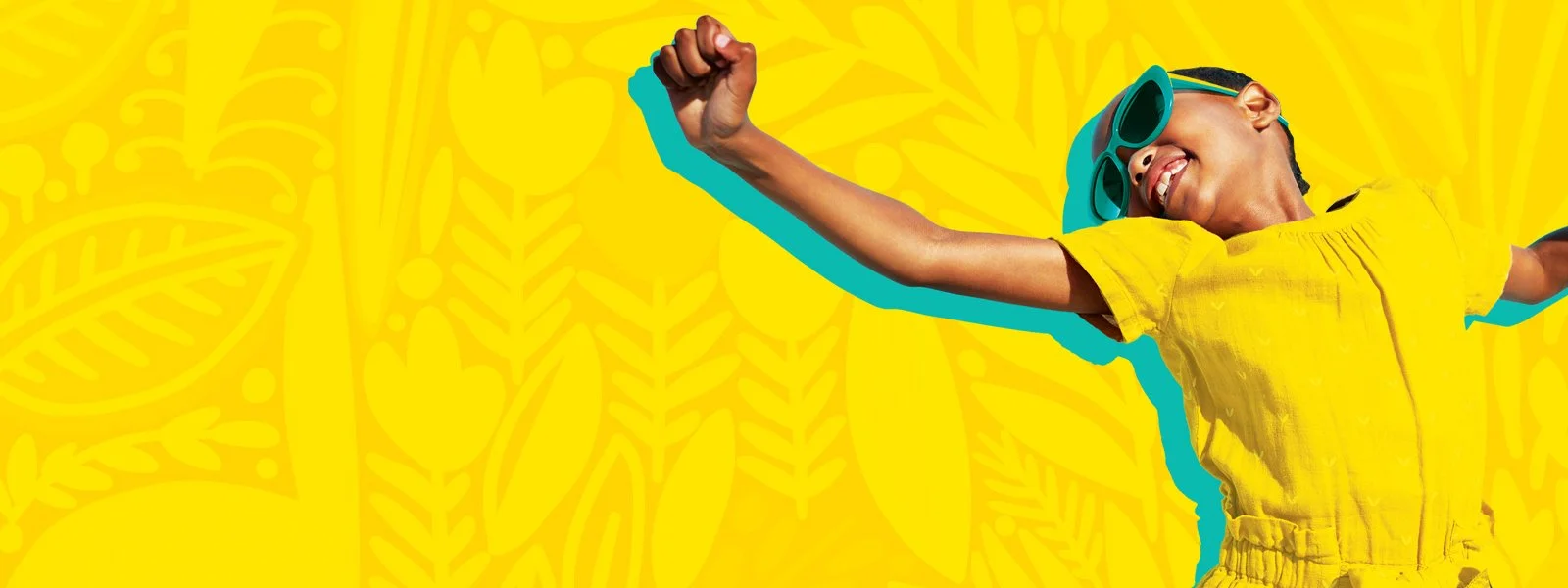
Curriculum
What if the purpose of schools was genius and joy?
Hear from Dr. Gholdy Muhammad about the new Genius and Joy K-5 elementary curriculum and how it answers that critical question.
For the first time, Dr. Gholdy Muhammad’s Genius and Joy framework is available as an all-in-one curriculum kit containing detailed lesson plans, authentic literature, explicit instruction, and student writing journals.
Dr. Gholdy Muhammad’s Five Pursuits framework of Identity, Skills, Intellect, Criticality, and Joy is a research-based instructional approach that enhances student engagement and achievement by focusing on literacy, identity development, and historical awareness. The Genius and Joy curriculum for Grades K-5 prioritizes academic rigor by developing literacy skills, building content knowledge and centering students’ learning experience on joy. The curriculum is deep in content and thought while also practical and easy to implement.
The Pursuit of Identity
This pursuit involves teaching and learning the multiple and diverse identities of students and others, such as culture, race, gender, and more. Identity can also include how a student develops in terms of interests, hobbies, and social practices. Through each Unit, students will have opportunities to learn who they are, whose they are, who they are not, and who they desire to be in the world.
The Pursuit of Skills
This pursuit involves the teaching and learning of multiple and diverse learning standards, competencies, and proficiencies. These skills are the actionable things we want students to be able to do, such as learning a certain skill or scoring well on a standardized test. The Genius and Joy Curriculum focuses on literacy and national English language arts(ELA) standards, while offering suggestions for cross-curricular extensions across the content areas of art, math, physical education/health, science, and social studies.
The Pursuit of Intellect
This pursuit involves the teaching and learning of multiple and diverse themes, topics, and knowledge set into action. Knowledge comes from many places; it can come from learning about new people, places, things, histories, current and local events, and concepts. Much of the Genius and Joy Curriculum’s pursuit of intellect includes knowledge related to history. As students gain knowledge, they will be able to form their own interpretations of information and truths.
The Pursuit of Criticality
This pursuit involves the teaching and learning of multiple and diverse ways to advance students’ consciousness and social awareness by teaching students how to name, understand, question, and disrupt injustice, hurt, harm, or pain within humanity and the world. Criticality is what helps to advance humanity and makes the world a better place for all to live, thrive, and have spaces for joy for everyone.
The Pursuit of Joy
This pursuit involves the teaching, uplifting, and recognition of beauty, aesthetics, truth, benefits, and personal fulfillment within humanity and the world. Examples include engaging students in art, music, wellness, healing, peace, happiness, self‑determination, collaboration, wonder, laughter, imagination, care, and advocacy. Joy is a space for belonging and love and a creative space where students feel free to be themselves and are free to dream.
What the Curriculum Contains
Build background knowledge with six engaging fiction or nonfiction texts in each grade.
Develop vocabulary and comprehension skills.
Support text analysis, inferencing, and reflection.
Anchor Texts
Follow a consistent before-, during-, and after-reading approach in detailed daily instruction that is tailored to each unit’s themes and topics.
Engage students in the ‘Five Pursuits’ with multimodal layered text suggestions integrated into each Unit Plan.
Strengthen peer interactions, as well as family and community connections, with collaborative learning projects.
Customize your instruction with flexible teacher notes.
Unit Plans
Display rich content including primary source videos and engage students with a slide deck for daily instruction.
Provide fluency, comprehension, content-area connections, and group work with a variety of practice and progress-monitoring worksheets.
Complete the student materials with additional unit-specific digital resources.
Digital Resources
Inspire students to read, reflect, and respond to questions related to a meaningful quotation, honing their writing and critical thinking skills through daily journaling activities.
Student Journals
Each grade covers six curriculum themes per unit:
Self & Identity
Pedagogy that relates to students learning about themselves and their various identities. In addition, students learn about diverse cultures and identities from around the world. Topics might include learning about self-identity, Indigenous cultures, environmental identities, and LGBTQIA+ communities.
Cultural Diversity, Community & Collectivism
Pedagogy that relates to students learning about cultural diversity, diversity of thought, and community, as well as principles that center on unity, togetherness, and helping one another. Topics might include teamwork through sport, cultural diversity, community stories, and neighborhood and family collectivism.
The Living and Social Environment
Pedagogy that relates to students learning about physical environments, social environments, and relationships with living things and organisms. This theme explores how living things interact within communities. Topics might include insects, biology, sea life, environmental justice, and nature.
Creativity, Literacy & Art
Pedagogy that relates to students learning about creativity, original art, expression, and imagination. Students engage in reading, writing, thinking, and communication. Topics might include reading, books, bookstores, writing, research, and creativity throughout history.
Advocacy & Activism
Pedagogy that relates to students learning about equity, justice, and the act of making the world a better place through social action and change. Topics might include freedom to travel, integration, anti-racism, and resistance to discrimination.
Building the Future
Pedagogy that relates to students learning about ways to think about, understand, and build a better world for the future. Topics might include technology, future thinking, and striving for positive change.
What Is Genius & Joy?
Genius is the intelligence, brilliance, special qualities, creativeness, uniqueness, knowledge, individual power, natural abilities, skills, talents, and light every student and educator holds. Historically, genius has not been a word used to refer to all students, but only a select few. Within this curriculum, we honor every single student—their special talents and the brilliance that they carry—as a genius. No student comes to a classroom without genius. Instead, it is up to us to recognize, affirm, cultivate, and nurture it.
Joy is beauty, aesthetics, creativity, and love in the self and humanity. Joy is the celebration and happiness as well as a sense of belonging. It includes space within the learning experience where students can live out and discover their fullest potential. Joy is art and music and creation. It is fostering wellness, healing, peace, happiness, self-determination, collaboration, wonder, laughter, imagination, care, and advocacy. Joy is a safe and creative space to be free—free to learn, free to dream, and free to be.
Teacher & Student Materials
The Teacher’s Guide is designed to help develop and prepare teachers toward successfully studying and implementing the Genius and Joy Curriculum. The Unit Plans contained within are designed for the teacher to “co-write” or “co-create” the Unit with the writers of the Genius and Joy Curriculum, so you will find lines for annotation, drawing, creating, and planning your own ideas. Within the Genius and Joy Curriculum is also Genius and Joy Journal for each student. The Journals elevate the themes carried in the Unit Plans. To complement each of the six themes, we also selected six anchor texts as well as multimodal texts such as video, photos, memes, primary source documents, music, songs, artifacts, objects, and digital interactive texts.
Research & Testimonials
The HILL Model for Culturally and Historically Responsive Education (CHRE) is covered deeply in Dr. Muhammad’s books Cultivating Genius and Unearthing Joy. The CHRE framework was developed through the teachings of Black literary societies and the scholarship of educational researchers who brilliantly paved the path. These genius minds include the culturally relevant, responsive, and sustaining scholarships of Gloria Ladson-Billings, Geneva Gay, Luis Moll, Kris Gutiérrez, Django Paris, Richard Milner, Tyrone Howard, Muhammad Khalifa, Bettina Love, Yolanda Sealey-Ruiz, Joyce King, Cynthia Dillard, Valerie Kinloch, and many others who center forms of Black educational history, genius, and joy in their works. The Genius and Joy Curriculum also builds upon the educational brilliance of historical scholars such as Mary McLeod Bethune, Anna Julia Cooper, James Forten, William Whipper, Maria Stewart, WEB Dubois, Carter G. Woodson, Toni Morrison, James Baldwin, and bell hooks. Through their work, this curriculum seeks to help educators understand how to define, reimagine, and redesign curriculum and instruction today.

Interested in Bringing Genius and Joy to your
School or District?
Create a learning community where every student’s genius shines—bring Genius and Joy to your classrooms today.








